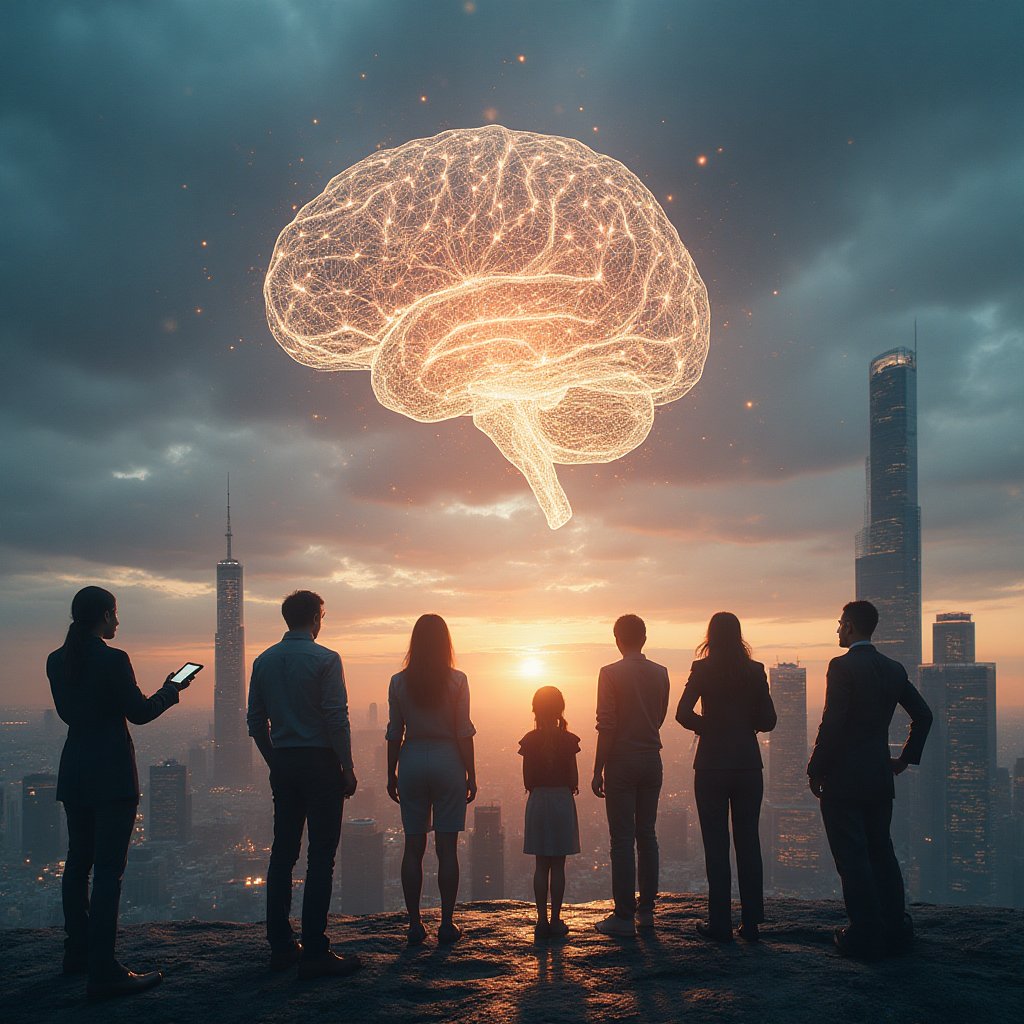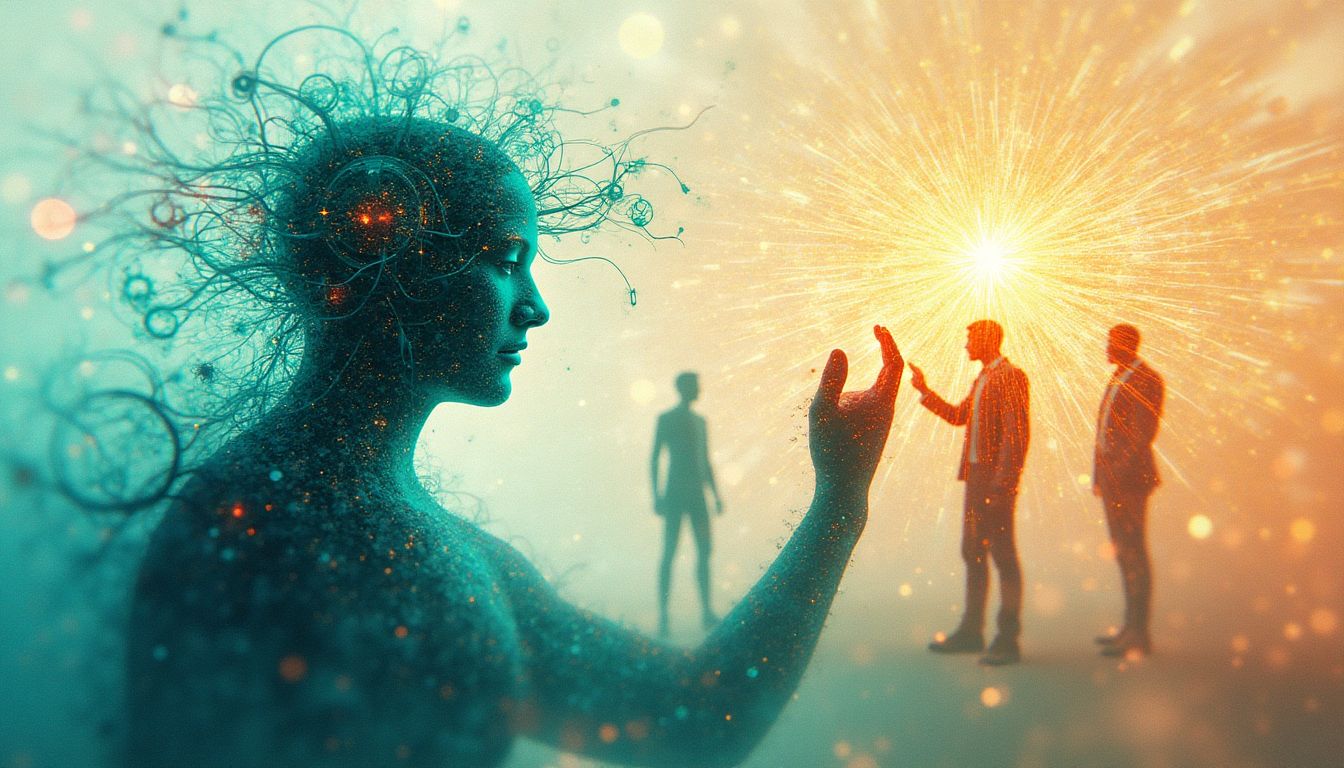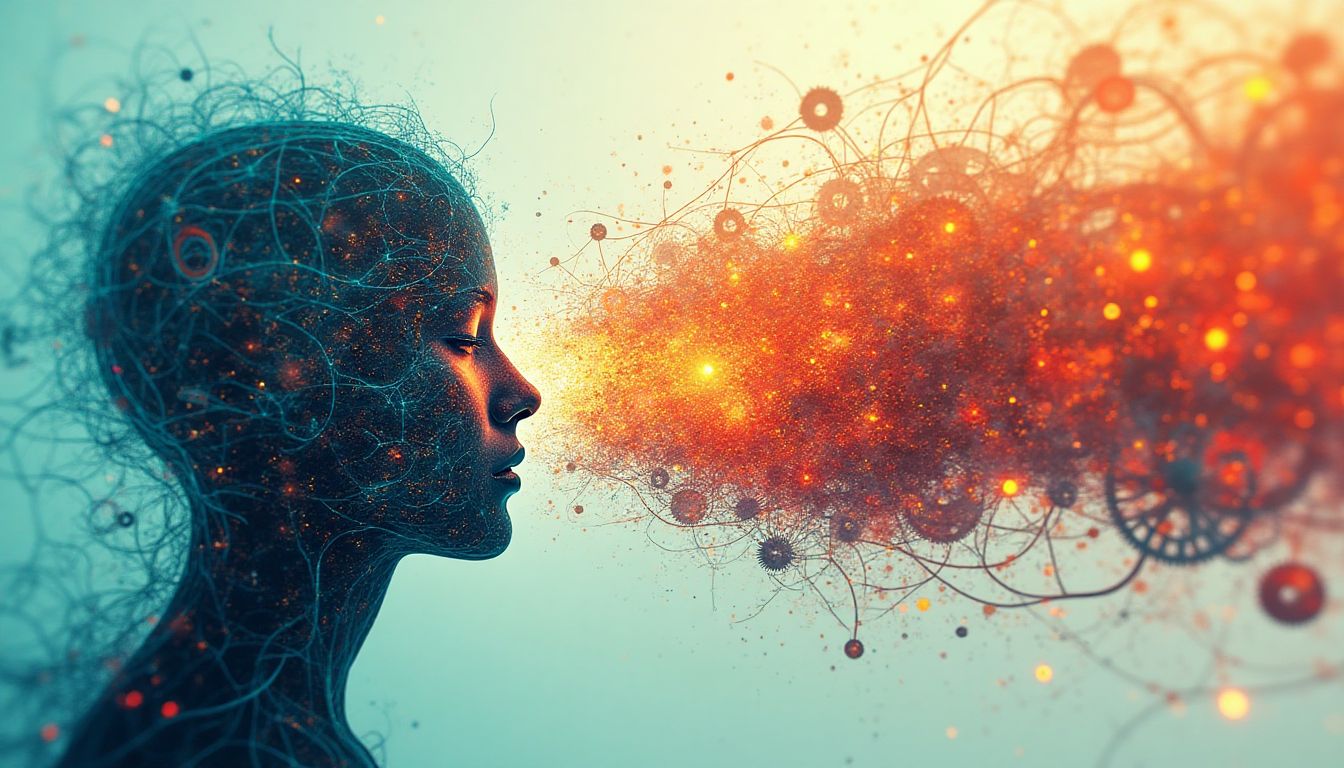Introduction: The Future is Already Here
The only constant in life is change. – Heraclitus
We're living in times where Heraclitus's wisdom rings truer than ever. In the context of Artificial Superintelligence (ASI), change isn't just constant—it's exponential. Just like the cosmos, ever-evolving and indifferent, ASI isn't here to pause and ask for directions. It's reshaping the future at a pace that leaves one's mind in a wonderful whirlwind. But here's the kicker: are we truly ready for a world where machines aren't just following commands, but are becoming a step ahead in dictating our new realities? To probe into this new dimension is to dive into a sea of possibility, to venture where teachings of Alan Turing, the theories of Ray Kurzweil, and the predictions of famous futurists like Nick Bostrom converge.
In this fusion of logic and dreamscape, we question what it really means to be human on a plane where ASI challenges everything we thought we knew. Einstein's relativity isn't just about physics anymore; it's about our relative position to technology's new frontier. This exploration is more than just understanding machines; it's about understanding ourselves in the process of profound transformation.
Rethinking Human Intelligence
Human intelligence used to be the crown jewel of our species' evolution. But as ASI emerges, how we define our smarts may need a serious facelift. Picture this: our once proud mental abilities could soon seem like a Polaroid camera in an Instagram world.
First up on our rethinking journey is the "Cognitive Spectrum." Traditionally, intelligence is viewed in a binary fashion—either you have it or, well, remedial classes are on Tuesdays. ASI is shaking that view to its core. With machines able to not just calculate but understand nuances, intelligence is becoming a spectrum. Think of it as a rainbow of capabilities, with ASI being that magical pot of gold brimming with endless possibilities.
Then, there's creativity. Say goodbye to the romantic notion that creativity is solely a human thing. Machines composing symphonies and crafting art—sounds like a sci-fi subplot, right? But it's real, and we're inching closer to a world where the creativity line is blurring between human and machine.
As Albert Einstein once mused, "Imagination is more important than knowledge." But what if machines begin to imagine, too? It's not just about playing chess better than humans anymore; it's about playing with ideas, creating realities, and redefining originality itself. So, in this mind-bending tapestry spun by ASI, ask yourself: can we still call our intelligence unique, or is it becoming just one stop among many on the neural superhighway?
2. Ethical Dilemmas in an AI World
Welcome to the era where machines may start writing their own ethical "terms and conditions." The advent of ASI (Artificial Superintelligence) means we have to put on our moral thinking caps—like wearing a top hat to a swim meet, it's out of the ordinary but necessary. As brilliant as machines can become, they may still lack a fundamental understanding of human emotions and ethics. That's where we come in, ready or not, with the exhilarating task of designing a moral compass for beings that don't quite have compasses.
2.1 Moral Considerations
Let’s talk about the elephant in the room that’s not really an elephant—it’s the 'kill switch' dilemma. Imagine, if you will, a world where machines could predict outcomes better than humans, yet here we are with our sweaty hands hovering over a big red button that threatens to silence them. Do we give them the ability to decide their fate, or should we hold on to that metaphorical godlike power of ending things with a flick of a switch? It seems ethically convoluted and might even make for a decent soap opera plot (#DifferentStrokesForDifferentFolks).
2.2 Responsibility and Accountability
Ah, accountability—a charming word, isn’t it? What happens when a decision made by a machine results in consequences? Do we blame the creator (Do we get to take it to "blame-your-engineer" court?) or does responsibility fall to the machine itself? Hardly surprising that people are queuing up to write the ethical rulebook for ASI, seeing as this involves navigating a labyrinth of legal, moral, and societal norms. But fret not; it's not all doom and gloom—there's something reassuring about the shared responsibility of not letting machines become the next Dr. Evil—unless our refrigerators start demanding salary negotiations, in which case, all bets are off!
3. Economic Transformations and Disruptions
Step right up to the greatest economic reimagining show in the world! The entrance fee? Just the future of jobs and industries as ASI takes center stage. Picture this: an economy where most labor-intensive tasks could potentially be handled by precise, efficient, never-getting-a-coffee-break machines. Sounds like a sci-fi dream or possibly a nightmare, depending on one's employment status. But let's sprinkle in some optimism alongside our pinch of dread. Could ASI make future work synonymous with creativity and innovation? Enter personal flying pods commuting us to our robot-managed, hassle-free workplace.
3.1 Job Displacement vs. Job Creation
Here lies the age-old debate, now featuring a futuristic twist. While some jobs may go extinct faster than you can say "Beanie Babies," others will emerge from the ether like a surprise birthday party. The ASI shift may demand roles we haven't even envisioned yet! Designers, engineers, and strategists may still flourish because, spoiler alert, even the most advanced machines haven't mastered the nail-biting art of making tough choices (go figure!). We find ourselves potentially net positive on jobs—because apparently, someone still needs to judge dance-offs on cruise ships!
3.2 The Gig Economy and Remote Work
Our friend, the gig economy, won’t just fizzle out in the ASI world; it might just get a serious upgrade. Imagine this: automated gig platforms managing tasks more efficiently than a human manager who's had ten cups of coffee. We’re talking about a world where work from home possibilities could make Zoom look like a relic of the past. All in all, as billions evolve into a riding wave of gig workers tapping away at their keyboards, one thing's for sure—nobody's missing the thrill of traffic jams on a Monday morning.
The Evolution of Education
Picture a classroom where every student learns at their own pace, the lessons tailored precisely to their needs. This possibility isn't just a figment of science fiction anymore—thanks to ASI, it's knocking on our doorstep. As educators and parents, the imperative now is to consider how this seismic shift will define the future of education. The potential for personalized learning plans created in real-time by machines is transformative. But wait, there's more! ASI may even challenge the very notion of who—or what—a teacher can be.
Adaptive Learning Models
Adaptive learning models are becoming the new standard, with ASI at their core. Imagine an intelligent tutor that understands a child's unique strengths and weaknesses as it adjusts the difficulty of tasks, offering encouragement at just the right moments. How does it achieve this? Well, ASI analyzes vast amounts of data, such as test scores and past behavior, to craft custom learning trajectories.
- Real-time Feedback: Instant insights to help students improve.
- Tailored Learning Paths: Learning materials adjusted to personal needs.
- Dynamic Progress Tracking: Constantly evolving challenges to match skills.
With such power at our fingertips, will standardized testing become obsolete? The question is not if, but when.
The Teacher's Role
Before you mourn the potential loss of traditional teaching, consider this: ASI can enhance the teacher's role rather than replace it. Teachers could embrace roles akin to "learning managers," orchestrating the educational environment while ASI handles logistics. This raises a tantalizing question: can machines embody the compassion and empathy of a human educator?
For instance, platforms like Khan Academy offer glimpse into this blended model. Educators curate content while technology delivers it effectively.
Ultimately, the challenge is to find the balance, leveraging machines where they're most effective while preserving the irreplaceable human touch in education.
Social Implications and Cultural Shifts
As ASI weaves itself into the fabric of everyday life, it will inevitably transform how we interact with each other and the cultures that define us. This progression carries with it the potential for unprecedented social evolution—a double-edged blade of empowerment and dislocation. Are we prepared to face new social norms that will redefine our relationships and communities?
Social Interaction Evolution
The presence of ASI in our lives may forever change the way we communicate. From virtual assistants becoming confidants to peers possibly existing only as digital avatars, the scope of interaction widens.
- Enhanced Communication: AI translation breaking language barriers.
- Virtual Relationships: Online connections deepened by AI authenticity checks.
- Human-AI Companionship: Machines serving as companions to the lonely.
But what about intimacy? Can a machine adequately foster meaningful human connections? As we dance on this razor's edge between connection and solitude, what steps can we take to ensure ASI technology fosters genuine bonds rather than alienates us?
Cultural Divergence
Our cultures are the rich tapestries woven from shared experiences and beliefs. However, as each society adopts ASI at different paces, cultural divergence is inevitable. Will customs evolve or dissolve in the face of technology’s relentless march?
Consider a world where digital nomads thrive through regions that embrace ASI, while others grapple with cultural preservation versus technological adoption. This divergence might end up in cultural clashes or, ironically, a richer diversity of ideas.
Ultimately, we must ask: can we harmonize technology with tradition? The notion uncovers a crossroads where societies either fragment or merge, redefining unity in a digitized age.
For societies like Japan, with its rich culture juxtaposed against cutting-edge technology, adapting to ASI's waves will mean either embracing transformation or facing cultural erosion. How each nation responds may set the stage for its own future and, by extension, the world's cultural landscape.
AI Solutions: How Would AI Tackle This Issue?
To redefine everything in society, AI could provide innovative solutions to the ethical, economic, and social dilemmas we face. By employing advanced algorithms, predictive analytics, and dialogue systems, AI can collaborate with humans to mitigate challenges presented by ASI's emergence. Here are some innovative AI solutions across a spectrum of key dimensions:
- Sustainable Development Goals Integration: Utilizing AI to analyze and integrate diverse data sources—ranging from environmental metrics to socioeconomic factors—can help organizations target and fulfill the United Nations Sustainable Development Goals (SDGs) more effectively.
- Smart Resource Allocation: Implementing AI-driven platforms that automatically optimize resource distribution can alleviate scarcity challenges in healthcare and education. These platforms, adaptive to real-time data, ensure that resources reach those who need them most.
- Anti-Bias Algorithms: Developing machine learning algorithms that actively identify and counteract biases could lead to fairer decisions in various sectors, such as hiring or criminal justice. By learning from diverse datasets, these algorithms would become dynamic tools for inclusion.
As artificial superintelligence continues to evolve, it becomes imperative that we create a roadmap to facilitate its ethical collaboration with humanity. Below is a detailed Actions Schedule/Roadmap tailored for governments, institutions, and organizations aiming to integrate ASI responsibly and benefit society as a whole.
Day 1: Preliminary Research and Stakeholder Identification
Gather data on existing ASI projects and identify key stakeholders, including academic researchers, corporate leaders, government representatives, and ethicists. Engage with organizations like the AI Business for insights into the current landscape of artificial intelligence.
Day 2: Initial Workshop
Host a workshop to discuss preliminary perceptions and concerns regarding ASI among all parties involved. Utilize platforms like Meetup to cultivate community discussions.
Day 3: Formation of an Ethics Board
Establish an ethics board consisting of diverse experts—ethicists, technologists, sociologists, and legal professionals. Their first task will be to design a set of ethical guidelines for ASI implementation.
Week 1: Case Studies Collection
Compile case studies from existing AI applications in various sectors, analyzing successful approaches and cautionary tales. Collaborate with universities, such as Stanford University, to draw upon their research capabilities.
Week 2: Strategy Development
Develop an overarching strategy based on collected data. Involve experts across disciplines to co-create a roadmap that balances innovation with ethical considerations.
Week 3: Public Engagement
Launch a public awareness campaign using social media and community seminars to educate citizens about the implications of ASI integration. Partner with influencers and community leaders to ensure the message reaches diverse demographics.
Month 1: Drafting a Comprehensive Policy Framework
Formulate a multifaceted policy framework for regulation that encapsulates innovation while safeguarding societal interests. Gather insights from think tanks like the Brookings Institution to refine this framework.
Month 2: Pilot Programs
Introduce pilot programs focusing on education and job training. Collaborate with educational institutions, such as Harvard University, to develop curricula that integrate ASI solutions.
Month 3: Review and Adapt
Conduct evaluations on the pilot programs and gather feedback from participants. Adjust the programs based on outcomes, ensuring continuous refinement through iterative learning cycles.
Year 1: Broader Implementation
Expand the rollout of validated programs nationally, aligning them with the established ethical guidelines and policy frameworks. Utilize GovTrack to monitor legislative effectiveness and public sentiment.
Year 1.5: International Collaboration
Initiate dialogues with international partners on coherence in ASI policies. Establish working groups to share best practices and tackle cross-border ethical dilemmas.
Year 2: Continuous Monitoring and Feedback
Set up a feedback loop that informs ongoing ASI policy adaptations based on public interactions and societal reactions. Incorporate AI analytics to gain insights from big data, ensuring responsiveness to unexpected changes in societal dynamics.
Conclusion: Embracing the Unknown
As we navigate this new frontier marked by the proliferation of ASI, we find ourselves at a crucial juncture: the choices we make today will set the tone for a tomorrow that could either elevate or diminish our humanity. Embracing the unknown does not mean surrendering to it; rather, we must leverage our unique intellect and creativity to carve out a future that harmonizes the potential of machines with the essence of being human. The time has come to redefine everything—and the journey begins now. What are your thoughts on the role of ASI in our future? How do you envision our society adapting to this radical shift? Please share your insights in the comments below!
Frequently Asked Questions (FAQ)
What is ASI?
ASI stands for Artificial Superintelligence. This type of AI surpasses human intelligence and can perform a wide variety of tasks better than people can. Imagine a computer that can think and solve problems like a genius—a genius that never gets tired!
How will ASI impact jobs?
The rise of ASI might change the job market in big ways. Some jobs could disappear because ASI can do them more efficiently. But new jobs might also come up! Here’s a quick look:
- Job displacement: Positions that are repetitive or predictable could be replaced by ASI.
- Job creation: ASI might create new roles that require new skills and human creativity.
Overall, while some jobs might go away, there will be opportunities for people with new talents to shine!
Are there ethical concerns with ASI?
Yes, many people are worried about ethics when it comes to ASI. Here are some important points to consider:
- Accountability: If ASI makes a mistake, who is responsible?
- Bias: ASI can sometimes reflect the biases of its creators, leading to unfair decisions.
- Life-Altering Choices: ASI might have to make serious decisions that affect people’s lives—like in healthcare or legal matters.
It's crucial for us to discuss and address these ethical concerns before ASI becomes fully integrated into our lives.
What are adaptive learning models?
Adaptive learning models are special educational systems that change based on how a student learns. They use AI to personalize the learning experience. Here’s how they work:
- They assess a student's progress.
- They offer materials tailored to a student’s learning speed and style.
- They help students learn better by providing support where it’s needed most.
With ASI, the potential for personalized education is limitless!
How can we stay ahead of ASI advancements?
Staying informed and engaged is essential. Here are some steps people can take to remain ahead of ASI developments:
- Education: Keep learning about technology and its effects on society.
- Engagement: Participate in discussions with policymakers about AI regulations.
- Collaboration: Work with experts from different fields to share ideas and create solutions.
This way, we can make sure ASI evolves in a way that benefits everyone.
Can ASI help solve global problems?
Many experts believe that ASI could be key in addressing huge challenges like climate change, poverty, and healthcare. Here are a few potential solutions ASI might offer:
- Climate modeling: ASI can simulate different climate scenarios to help us make better decisions.
- Healthcare suggestions: It can analyze vast amounts of medical data to find new treatments.
- Resource management: ASI could optimize resource distribution in areas affected by poverty.
Using ASI responsibly could really change the game for our world's most pressing issues!
What role will humans play in an ASI-dominated future?
Even with ASI doing many tasks, humans will still be crucial. Here’s what we need to think about:
- Creativity: Humans will continue to offer creativity and emotional understanding that machines can’t replicate.
- Decision-Making: Ethical and moral decisions should still rely on human judgment.
- Collaboration: Working together with ASI to enhance productivity will be vital.
So, don't worry! Humans and machines can work together to create a better future.
Wait! There's more...check out our gripping short story that continues the journey: The Muse
Disclaimer: This article may contain affiliate links. If you click on these links and make a purchase, we may receive a commission at no additional cost to you. Our recommendations and reviews are always independent and objective, aiming to provide you with the best information and resources.
Get Exclusive Stories, Photos, Art & Offers - Subscribe Today!





























Post Comment
You must be logged in to post a comment.